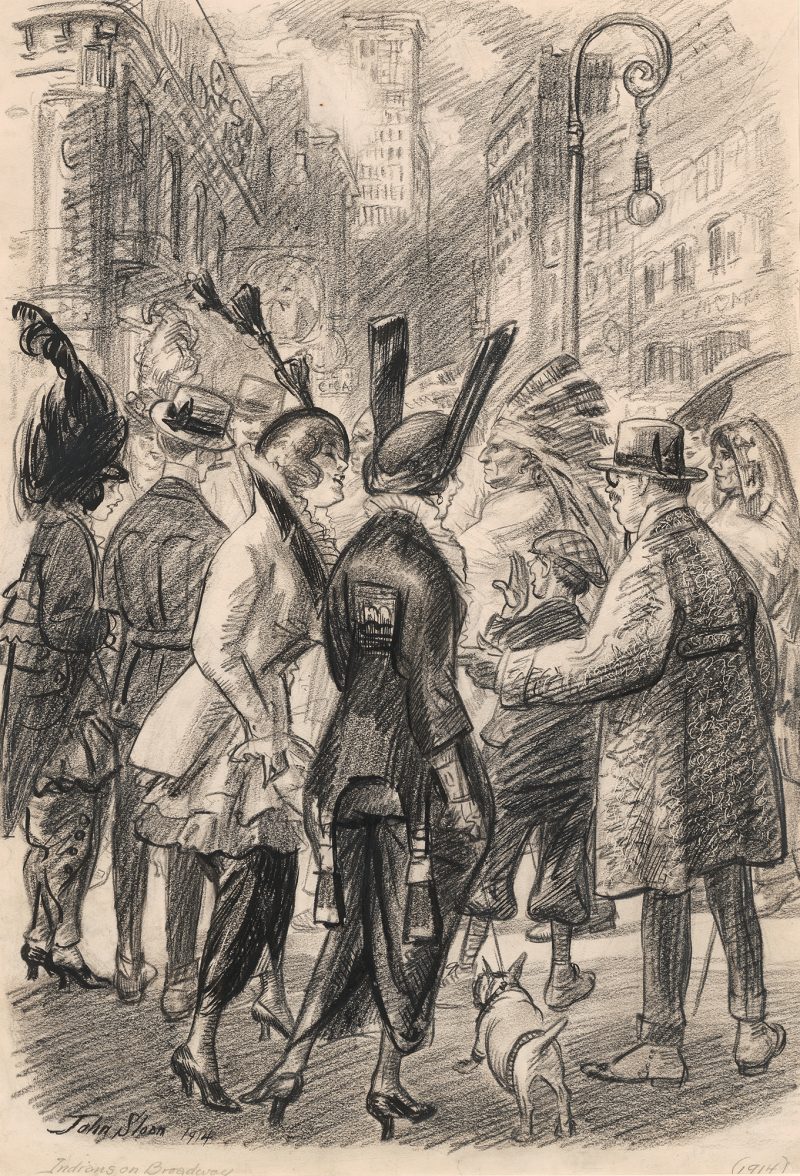
Indians on Broadway
Sloan, John
1914
Artwork Information
-
Title:
Indians on Broadway
-
Artist:
Sloan, John
-
Artist Bio:
American, 1871–1951
-
Date:
1914
-
Medium:
Crayon and ink
-
Dimensions:
21 3/4 x 15 1/8 in.
-
Credit Line:
Wichita Art Museum, Roland P. Murdock Collection
-
Object Number:
M107.52
-
Display:
Not Currently on Display
About the Artwork
Only a year after losing his job at the Philadelphia Press in 1903, John Sloan moved to New York City, where the demand for illustrators had lured many of his friends several years before. Soon after his arrival, Sloan found work as a freelance illustrator for several magazines, including Colliers and The Century. Freelance work was not steady, however, so Sloan, armed with his portfolio, began making the rounds of local publishers. It was during these trips that Sloan apparently discovered the people, places, and daily foibles of New York for the first time. This “everyday world” of New York, as Sloan called it, captivated the artist, and quickly became his favorite subject of study.1
Sloan’s interest in the “noble commonplace of nature”2 took a political turn in 1908 when one of his friends introduced him to socialism. Although he had once defiantly announced that “I am not a Democrat, I am of no party,” Sloan was soon preaching the ideals of socialism to anyone who might listen.3 “I tried to convert him to Socialism,” Sloan later wrote of an encounter with a truck driver, “but he is of the contented sort. Has a little home of his own, etc. No revolt in him.”4
From 1912 to 1916, Sloan contributed to and served on the editorial board of The Masses, a magazine supportive of socialist ideals. Working for The Masses liberated him from the stifling restrictions of commercial interests that dictated his work as a freelance illustrator. Indians on Broadway, which appeared in The Masses in July 1914, is not the heavy-handed propaganda of a proselytizing socialist, however, but a witty and satirical portrait of New York life. The drawing was inspired by an event Sloan witnessed during one of his strolls through the city, which he describes in his diary on 29 January 1907: “Coming back met Kirby and went to Durand-Ruel Galleries to see Monet’s several fine things. Foolishly, brazenly, modernly dressed women laughing at the costumes of squaws who pass Fifth Avenue corner of 34th Street. The squaws seemed the more rationally rigged.”5
In Sloan’s drawing, a procession of Native Americans passes through a crowd of New Yorkers who have gathered to watch the parade. The subject of the spectacle, however, is nearly obscured by the conspicuously fashionable spectators who crowd around the Native Americans in a claustrophobic phalanx. The hats of the two women in the center of the painting appear to sprout strange appendages and contrast with the Native Americans’ regal headgear. On the right side of the drawing, a boy holds his hand to his mouth, mocking the Native Americans’ war whoop in a cliched gesture. Drawn in profile, the Native Americans possess an air of stoicism and dignity—qualities conspicuously absent in the stylish crowd. Subtle but hardly tame, Sloan’s pithy send-up of New York’s haute culture is a fine example of his powers as a satirist and a self-described “spectator of life.”6
1. John Sloan quoted in Helen Farr Sloan, ed., John Sloan: New York Etchings (1905-1949) (New York: Dover Publications, Inc., 1978), viii.
2. Ibid., xi.
3. John Sloan quoted in Whitney Museum of Art, John Sloan, 1871-1951 (New York: Plantin Press, 1952), 41.
4. Ibid.
5. Bruce St. John, ed., John Sloan’s New York Scene: From the Diaries, Notes, and correspondence 1906-1913 (New York: Harper & Row, 1965), 101.
6. John Sloan quoted in Helen Farr Sloan, ix.